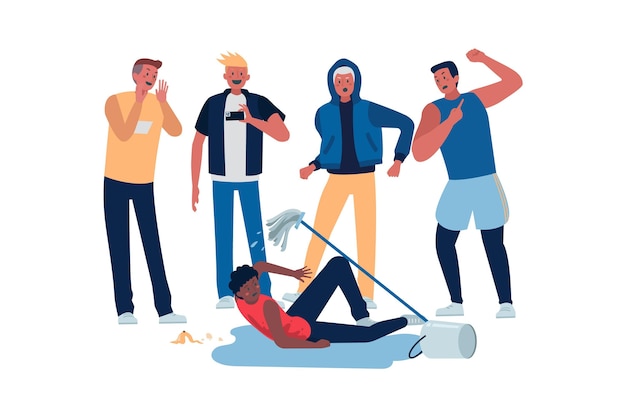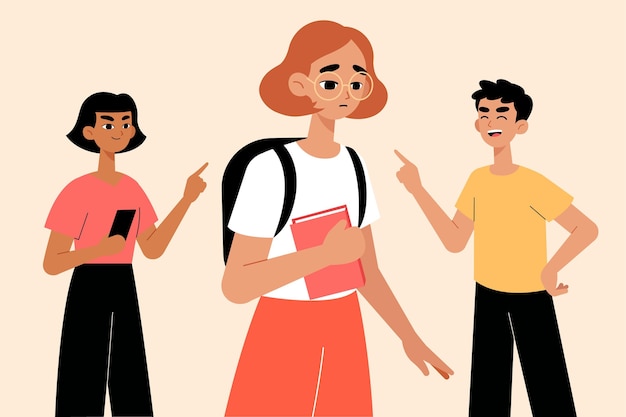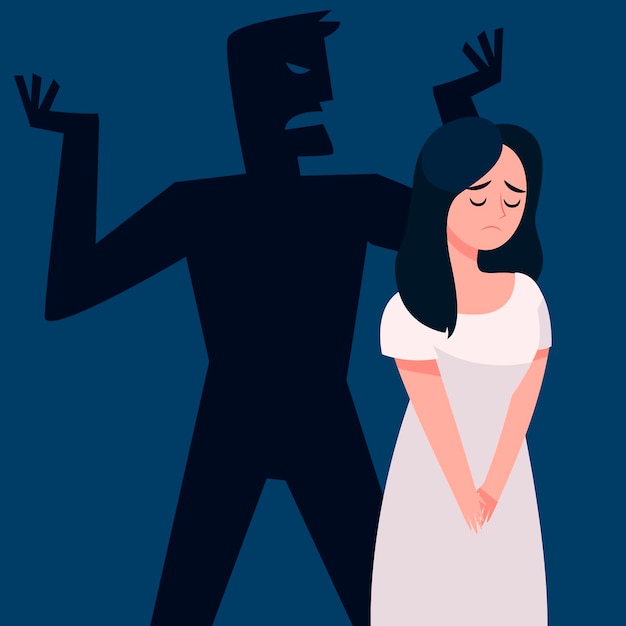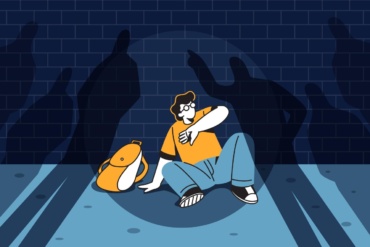In recent years the topic of bullying has probably become one of the most widely presented on subjects of school assemblies; I would be hard-pressed to find a reader amongst you that hasn’t had at least one assembly or classroom presentation or talk on the perils of bullying. And while there have been attempts to ensure that the narrative is as closely aligned with genuine student experience as possible, unfortunately, as with any generalization, some significant areas tend to get overlooked.
Trying to define it?
As a starting point in the interviews, therefore, I asked each of the interviewees to provide their own definition of bullying. For the purposes of privacy, these interviewees will remain anonymous. One student (let’s call her Meg) asserted that it was simply “A misuse of power or status. In some cases, it can also be a misuse of authority.”
Jo maintained a similar opinion, suggesting that “it’s really subjective, to be honest. I suppose I’d just say it’s the maltreatment of other people, really. Because it’s so broad and circumstantial I think it deserves a vague definition. Just treating others poorly.”
Amy, however, went on to suggest that “People say that causing one harm intentionally in any context is considered bullying, but the offender is only considered a bully after multiple offenses. The issue I have with ‘intentional’ is that sometimes bullying may be caused due to the negligence of another’s feelings or prioritizing oneself i.e. a joke at another’s expense or throwing someone else under the bus so you’re not in trouble respectively, in each of which the victim was collateral rather than the offender’s sole intention being to hurt them; regardless, I’d consider it bullying.”
The question of intentionality is a significant one because the intention of the ‘bully’ doesn’t always have to be that of inflicting harm, simply wanting to ridicule or put someone down to provoke laughter can fall under the term because it is not the severity of the action but rather the impact on the individual that is the determining factor.
Problems with media representations of bullying?
The portrayal of bullying in media has also had a hand to play in the development of a surprisingly exclusive narrative on bullying, with the stereotypical hollywood movie presentation of the ‘mean girl’ or the ‘steroid pumping jock’ subjecting the ‘nerdy girl’ or the ‘geeky guy’ to intense physical or emotional abuse, coming to encompass the very idea of what bullying means to a lot of young people.

When the question of the accuracy of the representation of bullying in media was posed to Amy, she related a similar sentiment, stating, “I think when we talk bullying, the scene that pops into all of our heads is an American high school with the jocks bashing the nerds against the lockers or the popular girls gossiping or spreading rumours.”
While she admits that it’s not to say that such representations are completely inaccurate, suggesting that “I don’t think bullying has been overtly-dramatised as I’ve read that these stereotypes really are the norm in most American public schools”, she equally raises the significant point of how “the impact of western culture in international media has clouded many other forms of bullying, especially emotional abuse, from getting the representation it needs.”
Indeed, the wide reaching influence of western media combined with the reiteration of very specific ideas of what bullying is supposed to ‘look like’ have created a widely accepted narrative on bullying- one that is both overly dramatic and negligent. As a consequence, for one to be ‘bullied’ the actions of the ‘bully’ are perceived as having to meet a certain, high standard in order for the act to qualify as ‘bullying’, resulting in the invalidation of the everyday, low profile experiences with bullying that many students have.
Amy exemplifies, saying, “in private schools or other cultures, being intelligent may be appreciated amongst pupils but famililal financial statuses or international schools may see racial discrimination to be recurring targets for bullies instead. This has prevented people from recognising that they’re in fact being bullied and have the right to seek help. It has also allowed for people to reassure themselves that they’re not bullies as they’re not for example punching someone in the eye, hence they guiltlessly proceed to hurt other people.”
Meg, who agreed with the inaccuracies of media portrayal on bullying also suggests that it “tends to be overdramatized and sometimes not all aspects of bullying are accurately portrayed, for example, the trauma that stays behind.”
“At worst” she says, “the media also glorifies being bullied.”
Personal experiences with low profile forms of bullying?
As they related their own heartbreaking experiences with these less evident and less represented forms of bullying, Amy talks of how “for me, the greatest impact of bullying came from any form of emotional abuse. As a person who has suffered from depression and other diagnosed psychological disorders for around five years now, it was really hurtful when I was constantly made fun of for my conflicting mental health. Even now, I find it difficult to talk about it to close friends due to repeated accusations of attention-seeking I’ve succumbed to. What this means is that I try to keep everything to myself, which is harder to deal with.”
“There is also this culture of leaving people out and isolating people that over the years have instilled this fear within me that there’s something wrong with me”, she continues
“I suspect it’s intentional but it should be a bare expectation for people to be inclusive. I think this social hierarchy system of being ‘popular’ or a ‘loner’ is common in many academic communities but it really is emotionally frustrating over prolonged periods of time.”
In situations like these where it is hard to evidence any exact areas that qualify the situation as bullying, and especially at higher grades, it is hard to see how the usual advice of reporting the bully into a teacher can be of any help to the victim.
“I think conventional advice offered in academic settings is notorious for their futility.” Amy maintains. “The main concern is that the individual’s current circumstances would worsen if the offender were to know that they had informed an adult. ‘Telling on’ someone is also seen as a disloyal act amongst peers, hence the individual also risks ostracism for coming forward.”
Meg, who admits that while such school solutions are in some cases, and particularly those that involve an obvious exhibition of ‘bullying’ behaviour, “pretty useful” also suggests that “sometimes, teachers fail to recognize that bullying comes in all forms, like microaggressions for example.”
Relating to her own horrifying experience of being severely bullied by daycare workers when she was only three, where the adults involved passed senselessly mean comments about her parents having left her orphaned and abandoned, she asserts that “As a child, if you ever feel threatened by someone in a position higher than yours, it is important that you communicate this with your elders. In many cases, when people in positions of authority have bullied and verbally abused children who are quiet and do not speak out, it gave the abuser freedom to wade into criminal territory- such as grooming and sexual abuse”.

However, she identifies the distinction between such experiences and the “ostracization” she faced in middle school, where she admits that speaking out would not have helped alleviate the situation. “When I found myself in situations where I was ostracized, despite being a confident and outspoken individual, I struggled to stand up for myself and began to develop an inferiority complex that took years to grow out of. Looking back, there really isn’t all that much I could have done other than to grit my teeth and bear it.”
Faced with similar issues at highschool, Jo talks about how for her it was her “best friend” for thirteen years who turned out to be the bully. “She was envious of me when I began performing better than her in music, drama and even athletics” she says, noting that “at the time I attempted to ignore it and any time I attempted to confront her she simply made me feel stupid for thinking that she was doing any of the things that she was doing.”
Looking back over the years of her friendship she relates how despite the emotional manipulation she endured- “she ditched me for new ‘best friends’ all the time but whenever she came crawling back afterwards I would always welcome her back with open arms, thinking it was just a phase”- it was hard for her to validate these feelings because there were no obvious signs of bullying from the outside, and “to everyone else, we were the ‘best friend’ duo who had known each other since grade school.”
In a 2010 survey of 40,000 high school students, 50 percent admitted to bullying other students within the past year, and 47 percent said they had been “bullied, teased, or taunted in a way that seriously upset them” (Josephson Institute, 2010)
Bullying is in reality far more common than many expect, and especially in contrast to the degree of exclusiveness with which it is treated in a lot of media. Far from conventional representations of physical violence or the ostracization of an individual by a group of students, the umbrella term of bullying also encompasses the less recognized forms of emotional manipulation, microaggressions, and indirect psychological attacks that often occur within friendship groups.
In a classic case of what she now realizes was gaslighting, Jo admits that up until this interview she still hadn’t ever actually classified her situation as ‘bullying’, suggesting that it simply didn’t align with what the media and school had suggested bullying was meant to look like. Much like the other interviewees, she was initially reluctant to see her own situation as a valid instance of bullying compared to the severity of those generally portrayed on screen.
How should people deal with these incidents?
When asked on how she would advise someone in a similar situation she says she understands that “just saying ‘talk to to someone’ has become so overused its almost meaningless, so schools and institutions need to put this across in a more meaningful and effective way because everyone already knows that this is what they are supposed to do and if they aren’t doing it it’s not because they don’t know, its because they can’t.”
Jo delves into more detail suggesting that, when faced with such instances of bullying within friend groups, “Try to think carefully, to think objectively. Disregard any history you have with them and even the connotations of the word bully. Just think, is this person treating me correctly? Is this person treating me the way they’re supposed to? And don’t overthink it, don’t start doubting your emotions, thinking ‘oh I’ve misinterpreted it’. Think about whether something makes you feel bad, whether this has happened before, whether this person has been your friend in the past before”.
She follows, relating to the idea of talking to someone else, saying “maybe try to speak objectively to someone who doesn’t know the bully in question. Layout the situation as it happens. Have them give you their unbiased opinion. No matter how small the issue seems on the surface when relating your experience objectively, if someone thinks it qualifies maltreatment then clearly, you’ve got a problem”
How should schools and institutions change or tailor their approach in order to effectively address these situations?
On asking them on how they believed these subtler forms of bullying could be effectively addressed, and whether they could propose a method of dealing with such incidents, Amy actually finds it hard to say there is one at all.
“Honestly, I’m not sure” she admits, “I’m under the impression that everything that could plausibly have been done has been implemented with little lasting success. That being said, I’m known to be pessimistic by nature (although I see it as realistic) and have very little experience having spent most of my upbringing in one school, so there may be means to eradicate incidences of bullying that I’m unaware of.”
“Kids are vicious”, Meg similarly asserts in her reply to whether these less addressed forms of ‘bullying’ can ever be truly brought under control. “It is extremely difficult to educate children on the long-term effects of bullying and being bullied. Even environments with zero-tolerance policies find it difficult to bring cases of bullying among students to a complete zero.”
Amy however, though she concurs saying “I don’t think these less addressed forms of bullying can ever be brought under control because they’re so circumstantial and there are so many manipulative people out there who are never actually called out for being manipulative because they’re so subtle about this”, proposes that “it would be really good to raise more awareness of this form of bullying because it’s much less recognized and can be a lot more damaging in the long run as it can really hurt someone’s perception of themselves especially if they never realize that they’re actually a victim to this sort of abuse”.
“Maybe incorporate these more subtle aspects of bullying into more high profile media” she continues. “There are so many shows out there that have that shallow, ostentatious version of bullying that’s so in your face, so obvious. I think more psychological representations of media would not only make for better storylines but help raise some really valuable awareness of how common this is and how students should approach the situation.”

Indeed, you can’t can’t always ‘tell on’ someone, and the unofficial justice systems in school which are founded on ideas of punishment for the bully and disciplinary action don’t work in a lot of these low profile bullying cases. A lot of the time, older more mature students need to be advised on how to differentiate for themselves between high and low profile bullying situations, and also then on healthy forms of dealing with these situations.
Another student (let’s call this one Beth) takes on a slightly different perspective on dealing with bullying. She suggests that “a sustained focus on mental health education from a young age and a conscious effort to equip students with psychological tools to manage their emotions could go a long way in addressing some of the underlying causes of bullying”
“Advice on combating bullying is often directed towards addressing specific cases of overtly unacceptable behaviour” she notes “rather than evaluating and trying to improve the overall social climate of a setting”.
“Advice on combating bullying is often directed towards addressing specific cases of overtly unacceptable behaviour” she notes “rather than evaluating and trying to improve the overall social climate of a setting”.
The necessity for a change in focus, be it from the grassroots level or on the manner of advice provided, nevertheless makes itself evident in the replies of these students, as well as of course, the fact that effecting genuine and lasting change will be nowhere near easy. Talking to someone works sometimes, but not always, and not always by itself.
The unofficial justice systems, contingent on disciplinary action, that have been set up within schools are more often aimed at absolving the institution of blame, or at tackling very specific and serious cases of bullying, allowing thousands more to slip beneath the desk. Teachers and administrators typically see only about 4 percent of bullying incidents suggests one survey. (Kazdin & Rotella, 2009)
Educators often shy away from advising kids to deal with situations as nuanced as bullying by themselves, and this is understandable, especially when teaching younger children. Too many incidents where students have attempted to take things into their own hands have ended messily. However, it stands to reason that in more mature students, those at middle or high school levels, it would be far more effective to inform them on the differences between situations that they can deal with by themselves and those where external intervention is necessary. Importantly, it could also educate them on how to deal with the lower profile situations by themselves, in a mature and healthy manner. It’s time to admit that the same old assemblies and talks on bullying and reporting aren’t all effective, new solutions need to be proposed, new codes of action need to be established, and this could be one of them.
As Amy asserts, “If students were to be more educated on how to distinguish between and deal with these different kinds of bullying situations, they’d be able to deal with their own situations in a way that best interests them.”
“If students were to be more educated on how to distinguish between and deal with these different kinds of bullying situations, they’d be able to deal with their own problems in a way that best interests them.”
Picture Credits:
People vector created by freepik – www.freepik.com
Concept vector created by pikisuperstar – www.freepik.com











